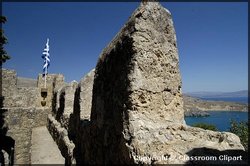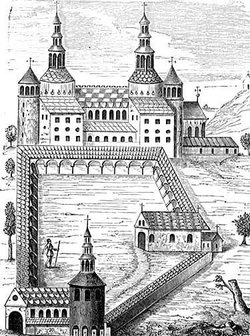Medieval architecture
|
|
| Middle Ages |
| by region |
| Medieval Britain |
| Medieval France |
| Medieval Germany |
| Medieval Italy |
| Medieval Spain |
| Byzantine Empire |
| by topic |
| Art |
| Literature |
| Poetry |
| Music |
| Architecture |
| Philosophy |
| Universities |
| Technology |
| Warfare |
| Fortifications |
Medieval architecture is a term used to represent various forms of architecture popular in the Middle Ages.
| Contents |
Religious architecture
The Latin cross plan takes as its model the Roman Basilica. It consists of a nave and two sections half its size flanking it, and the altar stands at the far end (the short end or "head" of the cross). Also, cathedrals influenced or commissioned by Justinian employed the Byzantine style of domes and a Greek cross (resembling a plus sign), centering attention on the altar at the center of the church.
Romanesque
Main article: Romanesque architecture
Romanesque, prevalent in medieval Europe during the 11th and 12th centuries, was the first pan-European style since Roman Imperial Architecture and examples are found in every part of the continent. The term was not contemporary with the art it describes but rather is an invention of modern scholarship based on its similarity to Roman Architecture in forms and materials. Romanesque is characterized by a use of round or slightly pointed arches, barrel vaults, cruciform piers supporting vaults, and groin vaults.
Gothic
Main article: Gothic architecture
In the 12th century Abbot Suger introduced the flying buttress, which proved a great innovation in supporting buildings. Beams came out and down from the building, resting much of the weight on the ground outside. The walls could then become thinner and even have windows. The windows installed contained beautiful stained glass, showing stories from the Bible and from lives of saints. The pointed arch provides another trademark of the Gothic style. Such new elements of design allowed cathedrals to rise taller than ever, and it became something of an inter-regional contest to built a church as high as possible.
Secular architecture
Surviving examples of medieval secular architecture mainly served for defense. Castles and fortified walls provide the most notable remaining non-religious examples of mediaeval architecture. Windows gained a cross-shape for more than decorative purposes: they provided a perfect fit for a crossbowman to safely shoot at invaders from inside. Crenelated walls (battlements) provided shelters for archers on the roofs to hide behind when not shooting.
Examples
Elements of medieval architecture
- corbel
- embrasure
- merlon
- jettying, in which the faces of upper floors project beyond lower ones
- half-timbered construction
See also
- Architectural style
- Bastides, a specific fortified town architecture used in medieval Francepl:Architektura średniowiecza


